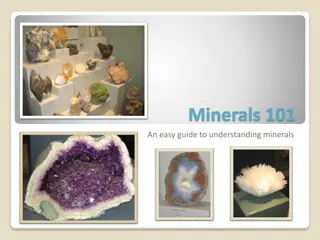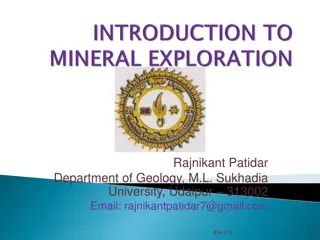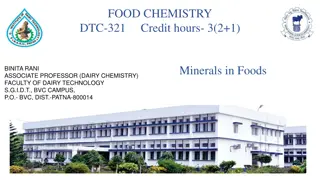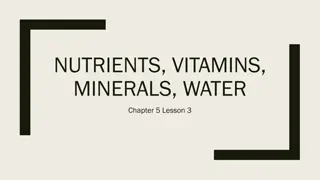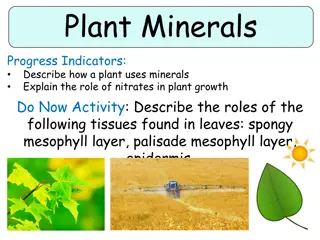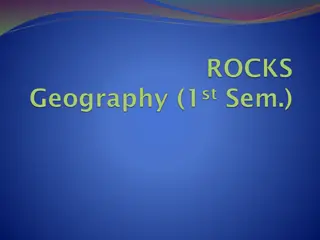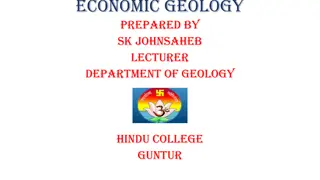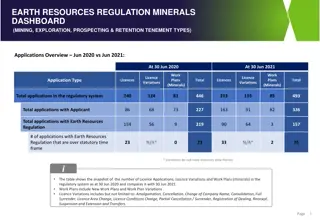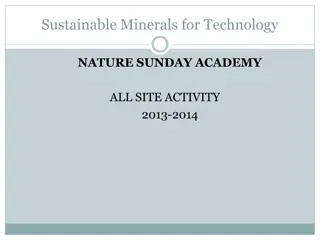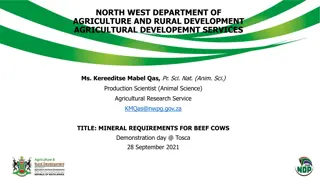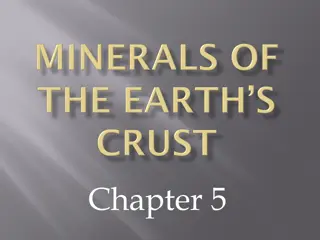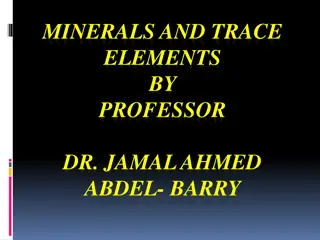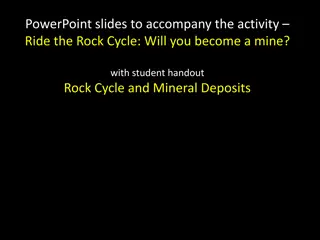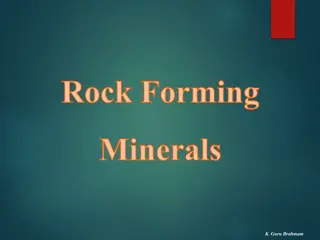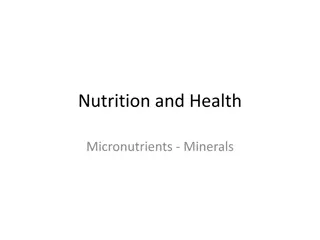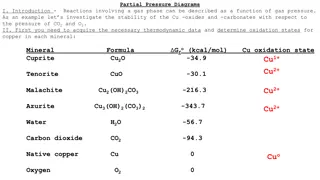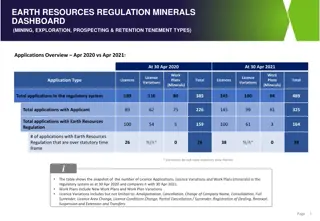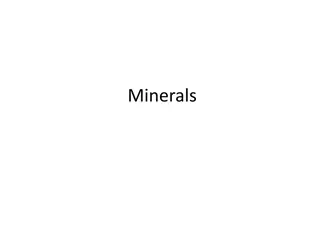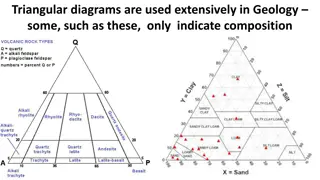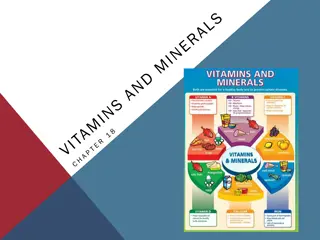Fascinating World of Minerals
Discover what minerals are, their characteristics, and how they form naturally. Learn about the distinction between minerals like quartz and silver versus substances like coal or glass. Explore the diverse categories of rock-forming minerals, including silicates and nonsilicates, and delve into their crystal structures.
Uploaded on Sep 15, 2024 | 1 Views
Download Presentation

Please find below an Image/Link to download the presentation.
The content on the website is provided AS IS for your information and personal use only. It may not be sold, licensed, or shared on other websites without obtaining consent from the author.If you encounter any issues during the download, it is possible that the publisher has removed the file from their server.
You are allowed to download the files provided on this website for personal or commercial use, subject to the condition that they are used lawfully. All files are the property of their respective owners.
The content on the website is provided AS IS for your information and personal use only. It may not be sold, licensed, or shared on other websites without obtaining consent from the author.
E N D
Presentation Transcript
What is a mineral? Naturally occurring inorganic (no living thing or remains) Solid Definite shape ( arranged in an orderly pattern) definite chemical composition
Is it inorganic? Coal? No, it is not a mineral- How is it made? magnetite Yes, a mineral pearl No, not a mineral- How is it made?
Does it occur naturally? Quartz yes, a mineral- one of the last minerals to form from a magma chamber. Silver yes, a mineral steel no, not a mineral- How is it made?
Solid in crystalline form? Petroleum no, not a mineral- What is its natural form? mercury no, not a mineral- What is its natural form? glass not a mineral- What is its form? amorphous
Definite chemical composition? Calcium yes, Ca a mineral Graphite yes, C Concrete no, not a mineral- Why?
Rock forming minerals Over 3000 minerals only 20 are common, these are rock forming minerals two main groups- silicates and nonsilicates
Silicates 96% of the crust contain silicon (Si) and Oxygen (O) Feldspars are the most common silicate minerals, contain Ca, K, and Na Examples- Orthoclase and plagioclase Ferromagnesium- contain Fe and Mg
Nonsilicates 4% of the crust No silica Six major groups carbonates-ex. Calcite halides- ex halite native elements- Made of one element ex. copper and silver oxides- hematite and corundum sulfates- gypsum sulfides- galena, pyrite
Crystal Structure Specific geometric arrangement of atoms or ions Crystal = natural solid with a definite shape Can be seen under microscope or with the aid of x rays
Identifying Minerals Characteristics of Minerals Each mineral has specific properties that provide useful clues for identifying minerals. Optical properties- properties will be identified by looking at the mineral. Tests- tools are used to run tests on the mineral.
Optical Properties Color Most easily observed ex. Sulfur is bright yellow, azurite is deep blue least reliable characteristic quartz consists of many colors weathering may hide true color
Luster Light reflected from the surface of a mineral metallic luster- like polished metal like silver All others are non metallic vitreous luster- reflects like glass pearly luster adamantine- brilliant luster ex. Diamond or gems other lusters include: waxy, greasy, dull, earthy
Crystal Shape Regularly shaped particles, or pattern. Most crystal shapes are hard to identify. six crystal systems cubic ex. Halite, Pyrite orthorhombic ex. Sulfur tetragonal ex. Chalcopyrite hexagonal ex. Plagioclase, Orthoclase monoclinic ex. Micas triclinic ex. Kyanite
Cleavage The tendency to split along certain flat surfaces and is related to types of bonds ex. Mica (general name) splits easily in one direction, it has one perfect cleavage ( splits in parallel sheets) Example- biotite and muscovite
Fracture Some minerals do not break along cleavage planes instead they fracture or break unevenly into curved or irregular pieces splintery or fibrous fracture- looks like pieces of broken wood conchoidal- curved surfaces like the inside of a shell
Simple Tests Streak Test The color of a mineral in powdered form observed by rubbing the mineral against a piece of unglazed ceramic tile called a streak plate the streak is not always the same color as the mineral mineral that have a hardness higher than the streak plate can not be tested
Hardness Test The ability to resist scratching hardness does not mean resistance to cleavage or fracture the hardness of an unknown mineral may be determined by using Moh s Hardness Scale -this scale lists 10 minerals in order of increasing hardness -Softest is talc with a hardness of 1 The hardest is diamond with a hardness of 10
Mohs Hardness Scale hardness common test easily scratched by fingernail 2 can be scratched by fingernail 3 can not scratch a copper penny fluorite 4 can easily scratch a penny Apatite 5 can barely scratch glass Feldspar 6 can scratch glass quartz 7 very easily/deeply scratches steel and glass topaz 8 scratches quartz corundum 9 no simple tests diamond 10 scratches everything Mineral talc gypsum calcite 1
Specific Gravity The ratio of the weight of the mineral to the weight of an equal volume of water. Each mineral has its own specific gravity Can be used to identify a mineral
Acid Test Used to easily identify calcite A drop of HCl dropped onto Calcite will cause it to effervesces. The bubbles are CO2gas. Dolomite also responds to the acid test but not as violently and only in powdered form.
Special Properties Magnetism- Can attach a magnet Fluorescence- the ability to glow under UV light ex. Calcite appears red under UV Phosphorescence- minerals that continue to glow after a UV light is removed.ex sphalerite
Special Properties cont Double refraction- crystals that bend light in such a way that they produce a double image of any object viewed. Radioactivity- certain atoms have unstable electron or neutron arrangements. These minerals activate a Geiger counter.

 undefined
undefined




















